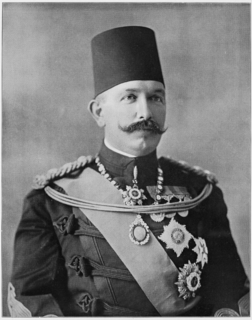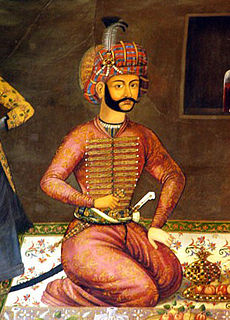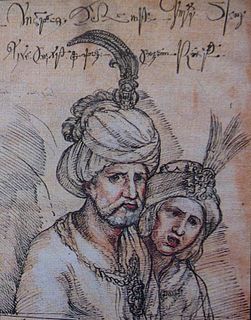
Abbas II Helmy Bey was the last Khedive of Egypt and Sudan, ruling from 8 January 1892 to 19 December 1914. In 1914, after the Ottoman Empire joined the Central Powers in World War I, the nationalist Khedive was removed by the British, then ruling Egypt, in favor of his more pro-British uncle, Hussein Kamel, marking the de jure end of Egypt's four-century era as a province of the Ottoman Empire, which had begun in 1517.

Abbas the Great or Abbas I of Persia was the 5th Safavid Shah (king) of Iran, and is generally considered one of the greatest rulers of Iranian history and the Safavid dynasty. He was the third son of Shah Mohammad Khodabanda.

The exilarch was the leader of the Jewish community in Persian Mesopotamia during the era of the Parthians, Sasanian and Abbasid Caliphate up until the Mongol invasion of Baghdad in 1258, with intermittent gaps due to ongoing political developments. The exilarch was universally regarded by the Jewish community as the royal heir of the House of David and held a place of prominence as both a rabbinical authority and as a noble within the Persian court. Within the Sasanian Empire, the exilarch was the political equivalent of the Catholicos of the Christian Church of the East, and was thus responsible for community-specific organizational tasks such as running the rabbinical courts, collecting taxes from Jewish communities, supervising and providing financing for the Talmudic academies in Babylonia, and the charitable re-distribution and financial assistance to needy members of the exile community. The position of exilarch was hereditary, held in continuity by a family that traced its patrilineal descent from antiquity stemming from king David.

Ibrahim ibn al-Walid was an Umayyad caliph, and a son of Caliph al-Walid I. He ruled from 4 October 744 to 4 December 744.
The names of people, battles, and places need to be spelled as they are on other articles title and then wikified.

Vakhtang V, born Bakhuta Mukhranbatoni, was the King of Kartli from 1658 until his death, who ruled as a vassal wali for the Persian shah. He is also known under the name of Shah Nawaz, which he assumed on being obliged outwardly to conform to Islam.

King Usermaatre SetepenreShoshenq III of the 22nd Dynasty ruled for 39 years according to contemporary historical records. Two Apis Bulls were buried in the fourth and 28th years of his reign and he celebrated his Heb Sed Jubilee in his regnal year 30. He was not a son of Osorkon II but instead a grandson through his dead father prince Takelot. As he was only a grandson, his cousin Takelot II contested his succession and Egypt was divided. He married his aunt Tjesbastperu to strengthen his claim. He outlived his first five sons and was thus succeeded by his 6th son Shoshenq IV, who later died childless as well and was succeeded by Shoshenq III's 7th son Pami.

Bagrat VII (1569–1619), also known as Bagrat Khan, was King of Kartli, eastern Georgia, effectively serving as a khan for the Persian shah Abbas I from 1615/1616 to 1619.

Shah Abbas II, was the seventh Safavid king (shah) of Iran, ruling from 1642 to 1666. Born Soltan Mohammad Mirza, he was the eldest son of Safi I with his Circassian wife, Anna Khanum.

Donboli is a Turkic-speaking Kurdish tribe living around Khoy and Salmas in West Azerbaijan Province in Iran.

Kingdom of Tashir-Dzoraget, alternatively known as the Kingdom of Lori or Kiurikian Kingdom by later historians, was a medieval Armenian kingdom formed in the year 979 by the Kiurikian dynasty, a branch of the Bagratuni dynasty, as a vassal kingdom of the Bagratid Kingdom of Armenia. The first capital of the kingdom was Matsnaberd, currently part of modern-day Azerbaijan.
Constantine I, also known as Constantine Khan, Constantin(e) Mirza, or Konstandil / Kustandil Mirza, of the Bagrationi Dynasty, was a king of Kakheti in eastern Georgia from March to October 1605.

Heraclius I or Nazar Alī Khān (1642–1709), of the Bagrationi dynasty, was a Georgian monarch who ruled the kingdoms of Kakheti and Kartli (1688–1703) under the protection of the Safavid dynasty of Iran.

Teimuraz I (1589–1661), of the Bagrationi Dynasty, was a Georgian monarch who ruled, with intermissions, as King of Kakheti from 1605 to 1648 and also of Kartli from 1625 to 1633. The eldest son of David I and Ketevan, Teimuraz spent most of his childhood at the court of Shah of Iran, where he came to be known as Tahmuras Khan. He was made king of Kakheti following a revolt against his reigning uncle, Constantine I, in 1605. From 1614 on, he waged a five-decade long struggle against the Safavid Iranian domination of Georgia in the course of which he lost several members of his family and ended up his life as the shah's prisoner at Astarabad at the age of 74.

Yarim-Lim II was the king of Yamhad succeeding his father Abba-El I.
Hatem "Beg" Ordubadi, was an Iranian aristocrat from the Ordubadi family, who served as the grand vizier of the Safavid king (shah) Abbas I from 1591 to 1610/1.
Mohammad Baqer Mirza better known in the West as Safi Mirza was the oldest son of king (shah) Abbas the Great, and the crown prince of the Safavid Dynasty during Abbas' reign and his own short life.
The Kingdom of Kakheti-Hereti or just the First Kingdom of Kakheti was an early Medieval monarchy in eastern Georgia, centered at the province of Kakheti, with its capital first at Telavi. It emerged in c. 1014 AD, under the leadership of energetic ruler of principality of Kakheti, Kvirike III the Great that finally defeated the ruler of Hereti and crowned himself as a king of the unified realms of Kakheti and Hereti. From this time on, until 1104, the kingdom was an independent and separated state from the united Kingdom of Georgia. The kingdom included territories from riv. Ksani to Alijanchay river and from Didoeti to southwards along the river of Mtkvari.












